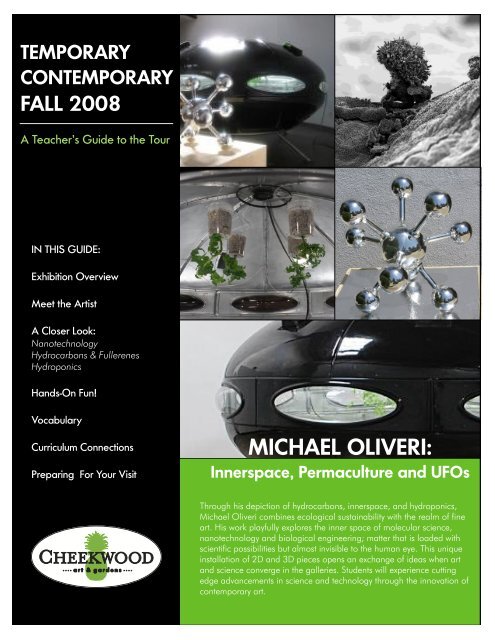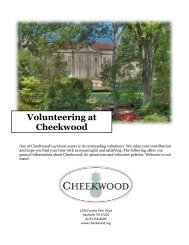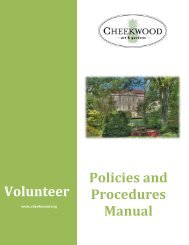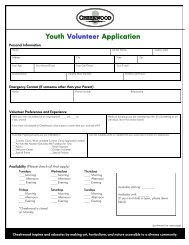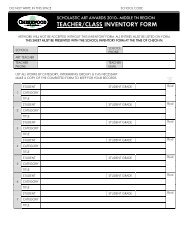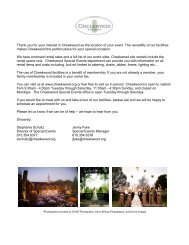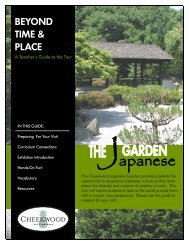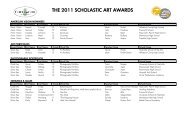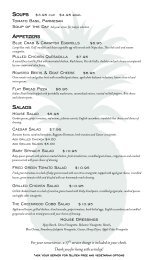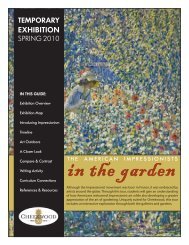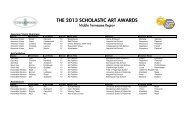Michael Oliver - Cheekwood Botanical Garden and Museum of Art
Michael Oliver - Cheekwood Botanical Garden and Museum of Art
Michael Oliver - Cheekwood Botanical Garden and Museum of Art
You also want an ePaper? Increase the reach of your titles
YUMPU automatically turns print PDFs into web optimized ePapers that Google loves.
TEMPORARY<br />
CONTEMPORARY<br />
FALL 2008<br />
A Teacher’s Guide to the Tour<br />
IN THIS GUIDE:<br />
Exhibition Overview<br />
Meet the <strong>Art</strong>ist<br />
A Closer Look:<br />
Nanotechnology<br />
Hydrocarbons & Fullerenes<br />
Hydroponics<br />
H<strong>and</strong>s-On Fun!<br />
Vocabulary<br />
Curriculum Connections<br />
Preparing For Your Visit<br />
MICHAEL OLIVERI:<br />
Innerspace, Permaculture <strong>and</strong> UFOs<br />
Through his depiction <strong>of</strong> hydrocarbons, innerspace, <strong>and</strong> hydroponics,<br />
<strong>Michael</strong> <strong>Oliver</strong>i combines ecological sustainability with the realm <strong>of</strong> fine<br />
art. His work playfully explores the inner space <strong>of</strong> molecular science,<br />
nanotechnology <strong>and</strong> biological engineering; matter that is loaded with<br />
scientific possibilities but almost invisible to the human eye. This unique<br />
installation <strong>of</strong> 2D <strong>and</strong> 3D pieces opens an exchange <strong>of</strong> ideas when art<br />
<strong>and</strong> science converge in the galleries. Students will experience cutting<br />
edge advancements in science <strong>and</strong> technology through the innovation <strong>of</strong><br />
contemporary art.
EXHIBITION OVERVIEW<br />
In his new <strong>Cheekwood</strong> exhibition ―Innerspace, Permaculture <strong>and</strong><br />
UFOs‖ <strong>Michael</strong> <strong>Oliver</strong>i continues his journey into the oddly everyday<br />
nature <strong>of</strong> human experiment. In several sculptures <strong>and</strong> photographs he<br />
dives into the material world that lies at the heart <strong>of</strong> scientific progress.<br />
His work playfully explores the inner spaces <strong>of</strong> molecular science,<br />
nanotechnology, biological engineering, in short, the small- <strong>and</strong> largesize<br />
matter that is loaded with scientific possibilities but almost invisible<br />
to the human eye. Take for instance nanotechnology which controls<br />
matter on the scale <strong>of</strong> an atom or molecule. In daily life, nano<br />
structures appear in sun lotion, cosmetics, stain resistant clothing, etc.<br />
The size <strong>of</strong> a nanometer to a meter is the same as that <strong>of</strong> a marble to<br />
the planet Earth. Collaborating with his colleagues in physics <strong>and</strong><br />
engineering at the University <strong>of</strong> Georgia by utilizing the most advanced<br />
scientific imaging technologies, <strong>Oliver</strong>i turns the scale on its head. In<br />
the resulting photographs, <strong>Oliver</strong>i harnesses nanotechnology for a<br />
different end, the aesthetic experience <strong>of</strong> seeing inner spaces revealed.<br />
Then there are the hydroponic tomato plants growing inside a UFO. A<br />
hydroponic tomato farm freshly flown in by extra-terrestrials? Some<br />
time ago such a story could only be the product <strong>of</strong> science fiction.<br />
Today strange things are possible outside the realm <strong>of</strong> fiction. In 1984<br />
NASA did indeed fly tomato seeds into outer space on board the Space<br />
Shuttle Challenger. Then elementary-school children around the United<br />
States were invited to use the seeds in science projects. During <strong>Oliver</strong>i‘s<br />
exhibition at <strong>Cheekwood</strong>, school children will also have the opportunity<br />
to conduct hydroponic experiments in a greenhouse lab – except this<br />
time the seeds have not gone to outer space.<br />
Jochen Wierich, Curator <strong>of</strong> <strong>Art</strong><br />
A pineapple designates topics for<br />
discussion <strong>and</strong> classroom activities.
MEET THE ARTIST<br />
<strong>Michael</strong> <strong>Oliver</strong>i received an AA degree in electronics at Orange Coast College, a BFA in Sculpture from San<br />
Francisco <strong>Art</strong> Institute, <strong>and</strong> an MFA in New Genres from the University <strong>of</strong> California, Los Angeles. Since<br />
2001, <strong>Oliver</strong>i has been an associate pr<strong>of</strong>essor <strong>and</strong> the Chair <strong>of</strong> Digital Media at the University <strong>of</strong> Georgia in<br />
Athens, Georgia. His work ranges from video <strong>and</strong> photography to sculpture, horticulture, <strong>and</strong> sound. Of his<br />
work <strong>Oliver</strong>i says, ―I‘m interested in s<strong>of</strong>t science. All the hypotheses that might someday be accepted fact –<br />
the ideas that aren‘t real yet, but you hope are true.‖ He believes advancements with the internet have given<br />
all ideas a voice. These voices form a discourse that mixes art <strong>and</strong> philosophy with just enough fact to make<br />
it seem real, even if just for a little while. Through his innovations in contemporary art, <strong>Michael</strong> <strong>Oliver</strong>i is<br />
emerging as an important American digital media artist.<br />
ARTIST STATEMENT<br />
I am conceptually driven, <strong>and</strong> intrigued by independent scientific discoveries, <strong>and</strong> theories that reveal<br />
coincidental relationships. Once I have absorbed the scope <strong>of</strong> my research I trust my intuition to<br />
weave these observations into a conceptually motivated aesthetic.<br />
My ideas for pseudo scientific objects, installations, videos <strong>and</strong> photography began in the early<br />
1990s. At first I was using animals <strong>and</strong> unsuspecting people in interactive sculptural sound<br />
installations. These works were experiments with cause <strong>and</strong> effect relationships. I was hacking <strong>and</strong><br />
modifying various emerging communications technologies as wireless interfaces to confound the<br />
common hierarchy <strong>of</strong> artist <strong>and</strong> viewer participant. This allowed for spontaneous <strong>and</strong> unpredictable<br />
relationships to manifest within the installations.<br />
By 2003, my work focused on cross-pollinating the arts <strong>and</strong> sciences. I was inspired by a daunting<br />
theory that the universe is potentially finite <strong>and</strong> shaped like a Fullerene carbon 60 molecule that is<br />
believed to potentially contain the essential amino acids necessary for life. I was provoked by the<br />
micro <strong>and</strong> macro geometric symmetry <strong>and</strong> more so by the potency <strong>of</strong> this metaphysical relationship.<br />
My creative investigations led to a poetic synthesis including topics on NASA research, hydroponics,<br />
sound waves, surfing, ultraviolet light <strong>and</strong> hydrocarbons, <strong>and</strong> the exhibitions ―Fast Food,<br />
Hydrocarbons <strong>and</strong> Waves in Outer Space‖, ―UV Hydrocarbons‖ <strong>and</strong> ―Ultraviolet Acquiescence <strong>and</strong><br />
Deep Space Drip Culture‖. Currently, I am collaborating with a team <strong>of</strong> nano scientists at the<br />
University <strong>of</strong> Georgia to create imagery from the structures produced in the lab. Although the<br />
scientists are observing the nano structures as objects, I am approaching them as subjects <strong>and</strong><br />
discovering new micro <strong>and</strong> macro relationships that I have yet to fully underst<strong>and</strong>.<br />
Using current photographic technology <strong>and</strong> a Scanning Electron Microscope (SEM) I have recently<br />
created my own gr<strong>and</strong> scale micrograph interpretation <strong>of</strong> their research. It is a series <strong>of</strong> micrographs<br />
called ―innerspace.‖ In this series I selected perspectives <strong>of</strong> unusual microscopic happenings within<br />
the actual nano structure samples to blur scale into seemingly familiar human settings.<br />
<strong>Michael</strong> <strong>Oliver</strong>i<br />
MICHAEL OLIVERI
A CLOSER LOOK<br />
WHAT IS NANOTECHNOLOGY?<br />
Nanotechnology is the art <strong>and</strong> science <strong>of</strong> manipulating matter at the<br />
nanoscale (down to 1/100,000 the width <strong>of</strong> a human hair) to create new <strong>and</strong><br />
unique materials <strong>and</strong> products. The nanoscale is the scale <strong>of</strong> atoms <strong>and</strong><br />
molecules, the fundamental building blocks <strong>of</strong> the material world. At the<br />
nanoscale, scientists can start changing the properties <strong>of</strong> materials directly,<br />
making them lighter, harder or more durable. In some cases, simply making<br />
things smaller changes their properties—a chemical might take on a new<br />
color, or start to conduct electricity when re-fashioned at the nanoscale. Thus,<br />
nanotechnology is a highly multidisciplinary field, drawing from a number <strong>of</strong><br />
branches <strong>of</strong> engineering, physics, colloid sciences, chemistry, robotics, <strong>and</strong><br />
more.<br />
Generally, nanotechnology refers to the development, separation, <strong>and</strong><br />
consolidation <strong>of</strong> materials 100 nanometers or smaller. A Nanometer is a unit<br />
<strong>of</strong> length in the metric system, equal to one billionth <strong>of</strong> a meter. To put it into<br />
perspective, the size <strong>of</strong> a nanometer to a meter is the same as that <strong>of</strong> a marble<br />
to the planet Earth.<br />
NANOTECHNOLOGY NOW &<br />
IN THE FUTURE<br />
Currently, there are more than six hundred nanotechnology-enabled consumer<br />
products on the market. Nanotechnology is used to make bicycle frames <strong>and</strong><br />
tennis rackets lighter <strong>and</strong> stronger. Nano-sized particles <strong>of</strong> titanium dioxide<br />
<strong>and</strong> zinc oxide are used in many sunscreens, to block UV radiation more<br />
effectively without making your skin look pasty white. Clothes are treated with<br />
nano-engineered coatings that make them stain-pro<strong>of</strong> or static-free. Computer<br />
chips using nanoscale components are everywhere in consumer electronics,<br />
from computers to mp3 players.<br />
Nanotechnology has enormous potential to change society; however, it<br />
remains a science in its infancy. Future applications <strong>of</strong> the science will become<br />
increasingly sophisticated, giving scientists <strong>and</strong> engineers the ability to tackle<br />
challenging problems that affect us all. Nano science could lead to important<br />
innovation in treating cancer, generating renewable energy, <strong>and</strong> providing<br />
clean water at any location. Fleets <strong>of</strong> medical nanorobots smaller than a cell<br />
could roam our bodies eliminating bacteria, clearing out clogged arteries,<br />
<strong>and</strong> reversing the ravages <strong>of</strong> old age. Clean factories could eliminate<br />
pollution caused by manufacturing. Low cost solar cells <strong>and</strong> batteries could<br />
replace coal, oil <strong>and</strong> nuclear fuels with clean, cheap <strong>and</strong> abundant solar<br />
power. Food production could increase ten times per square foot.<br />
Like many new technologies, there are concerns about the development <strong>and</strong><br />
use <strong>of</strong> nano science. Scientists face the challenge <strong>of</strong> upholding safety <strong>and</strong><br />
ethical st<strong>and</strong>ards as they work to advance the science.<br />
EXHIBITION<br />
CONNECTION<br />
<strong>Art</strong>ists find inspiration for their work<br />
in many different places. <strong>Michael</strong><br />
<strong>Oliver</strong>i found his after a simple<br />
Google search. His interest in<br />
nanotechnology, hydrocarbons, <strong>and</strong><br />
hydroponics began when he read an<br />
internet article which indicated that<br />
our universe – the whole cosmos –<br />
may be finite. Rather than being<br />
infinite in scope, this article<br />
suggested that the universe has a set<br />
size <strong>and</strong> number <strong>of</strong> entities. <strong>Oliver</strong>i<br />
thought it might be fun if the<br />
information were true <strong>and</strong> started to<br />
explore the idea through his artwork.<br />
To further investigate this scientific<br />
hypothesis, <strong>Oliver</strong>i began looking<br />
through a Scanning Electron<br />
Microscope to expose the tiny<br />
nanoscale molecules that make up<br />
the universe. Through his Innerspace<br />
series, he gives an up close <strong>and</strong><br />
personal view <strong>of</strong> the unseen<br />
subatomic world where materials<br />
behave dramatically different than<br />
they do in the macro one.<br />
Somewhat humorously yet, from<br />
specific scientific observation, he<br />
makes the point that innovation <strong>of</strong>ten<br />
occurs not as a result <strong>of</strong> structured<br />
research, but <strong>of</strong> accidental<br />
discoveries. Images in the exhibition<br />
reflect <strong>Oliver</strong>i‘s depiction <strong>of</strong> the true<br />
spirit <strong>of</strong> the scientific endeavor –<br />
successful, failed, unproved or<br />
ab<strong>and</strong>oned – as a dynamic<br />
conversation based not in reality but<br />
in potential.<br />
NANOTECHNOLOGY
HANDS-ON FUN<br />
BUMPY<br />
All <strong>of</strong> the tools used in nanotechnology share a common challenge <strong>of</strong> working in a world so tiny that materials behave<br />
dramatically different than they do in the macroworld, or big world. Materials at the nanoscale are characteristically bumpy,<br />
due to distinct molecular shapes; sticky from strong electrostatic forces; <strong>and</strong> shaky because they are in constant motion. At<br />
the nanoscale, nature follows a different set <strong>of</strong> rules that can be both awesome <strong>and</strong> unpredictable. The tools <strong>and</strong> machines<br />
used for nanotechnology are specially equipped to adapt to these qualities. For example, an Atomic Force Microscope<br />
uses a highly sensitive laser that produces graphic images <strong>of</strong> the particles topography.<br />
TRY IT!<br />
Simulate this process by making a pencil rubbing <strong>of</strong> a coin.<br />
Place a piece <strong>of</strong> paper over a coin. Rub a pencil slowly across the coin until the image is visible. You are able to detect<br />
ridges <strong>and</strong> bumps without looking at the coin. Imagine getting a similar graphic image <strong>of</strong> the surface <strong>of</strong> something so tiny<br />
no human eye could ever see it!<br />
STICKY<br />
Gravity is an important part <strong>of</strong> our lives in the macroworld, but at the nanoscale, particles as small as atoms are influenced<br />
more by frictional <strong>and</strong> electromagnetic forces. These intermolecular forces are tiny but strong, <strong>and</strong> bind atoms together.<br />
Stickiness occurs due to scale. Unlike the macroworld, at the nanoscale the higher the surface area, the stickier the material.<br />
Surface area to volume ratio increases as scale size decreases. For example, smaller particles have a higher surface area to<br />
volume ratio than larger particles.<br />
TRY IT!<br />
Materials: Granulated Sugar, Powdered Sugar, Sugar Cubes<br />
Ask students to discuss which <strong>of</strong> the sugars would stick the most to their h<strong>and</strong>s if they were to put their h<strong>and</strong> in each<br />
container. Students should take turns placing a h<strong>and</strong> in each container. (They should clean their h<strong>and</strong> between containers.)<br />
Discuss why they think certain types <strong>of</strong> sugar stuck to their h<strong>and</strong>s more than others. How does the surface area to volume <strong>of</strong><br />
each particle play a role in the results? What implications do the observations have for elements in nature‘s structure <strong>and</strong><br />
function?<br />
SHAKY<br />
At the nanoscale nothing is ever completely still. Molecules are constantly shaking <strong>and</strong> bombarding each other because <strong>of</strong><br />
changes in temperature. When thermal forces (temperatures) are low, molecules move very slowly. As the thermal forces<br />
increase, the molecules begin to shake more <strong>and</strong> more until they are constantly attacking each other.<br />
TRY IT!<br />
Materials: 3 small beakers; 1 filled with cold water, 1 with temperate water, 1 with hot water, food coloring, timer<br />
Students will explore how thermal forces affect the shakiness <strong>of</strong> molecules by testing the rate <strong>of</strong> diffusion <strong>of</strong> a drop <strong>of</strong> food<br />
coloring in water at different temperatures. Label three small beakers or glasses as cold water, room temperature water, <strong>and</strong><br />
hot water. Add the cold water to the first glass <strong>and</strong> then slowly place three drops <strong>of</strong> food coloring in the water. Time how<br />
long it takes for the food-coloring molecules to ―shake‖ <strong>and</strong> disperse evenly. Record your observations <strong>and</strong> repeat with the<br />
other two beakers. Note: Students should not stir or swirl glasses so they may see the molecules ―moving‖ on their own. Ask<br />
the students why the food coloring dispersed differently in the three beakers.<br />
(Explorations adapted from Science Scope, March 2008, volume 31, Number 7)<br />
BUMPY, STICKY & SHAKY
HANDS-ON FUN<br />
THE<br />
SCANNING<br />
ELECTRON<br />
MICROSCOPE<br />
Ask your students to look closely at <strong>Michael</strong> <strong>Oliver</strong>i‘s Innerspace: Fractal<br />
Geometric Valley. This image <strong>of</strong> molecules seen through a Scanning Electron<br />
Microscope is what <strong>Oliver</strong>i refers to as a nano photograph. He has been<br />
collaborating with Dr. Zhengwei Pan <strong>and</strong> his research team in the Physics <strong>and</strong><br />
Engineering Department at the University <strong>of</strong> Georgia to create imagery from<br />
structures produced in their labs. Although the scientists are observing the nano<br />
structures as objects, he is approaching them as subjects <strong>and</strong> discovering new<br />
micro <strong>and</strong> macro relationships that he has yet to fully underst<strong>and</strong>.<br />
INTERPRET<br />
<strong>Oliver</strong>i has taken scans from the SEM <strong>and</strong> pieced them together to create his<br />
Innerspace images.<br />
The scanning electron microscope<br />
has a magnification range from15x<br />
to 200,000x (reached in 25 steps)<br />
<strong>and</strong> a resolution <strong>of</strong> 5 nanometers. It<br />
creates the magnified images by<br />
using electrons instead <strong>of</strong> light waves<br />
<strong>and</strong> shows detailed 3-dimensional<br />
images at much higher<br />
magnifications than possible with a<br />
light microscope. Without light<br />
waves, the images are rendered in<br />
black <strong>and</strong> white. <strong>Michael</strong> <strong>Oliver</strong>i has<br />
entered a new frontier <strong>of</strong> art by<br />
presenting these unique images <strong>of</strong><br />
the nano world. It is through<br />
innovations in contemporary art like<br />
Innerspace that place <strong>Michael</strong> <strong>Oliver</strong>i<br />
among the important American<br />
digital media artists.<br />
What does this image appear to be?<br />
What elements are included in the composition to make you think this?<br />
How is texture used to help create the mood <strong>of</strong> the composition?<br />
Is there a feeling <strong>of</strong> space? Is it flat or deep space?<br />
Why do you think he gave it the title Fractal Geometric Valley?<br />
How does the black <strong>and</strong> white color scheme affect the mood <strong>of</strong> the piece?<br />
Does this image tell a story? If so, what could it be?<br />
INNERSPACE INTERPRETATION
A CLOSER LOOK<br />
WHAT IS A HYDROCARBON?<br />
Hydrocarbon is the simplest organic compound consisting entirely <strong>of</strong> hydrogen<br />
<strong>and</strong> carbon. The majority <strong>of</strong> hydrocarbons found naturally occur in crude oil,<br />
natural gas, <strong>and</strong> coal where decomposed organic matter provides an<br />
abundance <strong>of</strong> carbon <strong>and</strong> hydrogen. When bonded, the molecules can form<br />
limitless combinations <strong>of</strong> simple chains, branching chains, rings, or other<br />
structures. Hydrocarbons can be as simple as methane (CH 4 ) or highly<br />
complex like petroleum <strong>and</strong> can occur as gases, liquids, solids, or polymers<br />
like plastics <strong>and</strong> proteins.<br />
WHAT IS A FULLERENE?<br />
Fullerenes are a form <strong>of</strong> carbon consisting <strong>of</strong> up to 500 carbon atoms<br />
arranged in closed shells. This particular hydrocarbon was discovered in 1985<br />
by Robert Curl, Harold Kroto <strong>and</strong> Richard Smalley at the University <strong>of</strong> Sussex<br />
<strong>and</strong> Rice University. They received the 1996 Nobel Prize in Chemistry for their<br />
discovery <strong>of</strong> a before unknown allotrope <strong>of</strong> carbon, in which the atoms are<br />
arranged in closed shells. This form was found to have the structure <strong>of</strong> a<br />
truncated icosahedron*(see diagram below) <strong>and</strong> was named<br />
Buckminsterfullerene, after Fuller who designed the geodesic dome in the<br />
1960s.<br />
C60s<br />
By far the most common fullerene is C 60 , also called a buckyball. C 60 is a<br />
molecule that consists <strong>of</strong> 60 carbon atoms, arranged as 12 pentagons <strong>and</strong> 20<br />
hexagons. The shape is the same as that <strong>of</strong> a soccer ball. The black pieces <strong>of</strong><br />
leather are the pentagons, the hexagons are white. There are 60 different<br />
points where three <strong>of</strong> the leather patches meet. Imagine a carbon atom sitting<br />
at each <strong>of</strong> these points, <strong>and</strong> you have a model <strong>of</strong> the C 60 molecule.<br />
The discovery <strong>of</strong> C 60 has stimulated innovative activity in chemistry. It opened<br />
up the new branch <strong>of</strong> Fullerene-Chemistry which studies the families <strong>of</strong><br />
molecules that are based on fullerenes. Experiments combining fullerenes with<br />
other atoms are leading to the development <strong>of</strong> new superconductor<br />
compounds. Below a certain temperature these compounds can conduct<br />
electric currents without any resistance. How might this influence our future<br />
energy needs?<br />
EXHIBITION<br />
CONNECTION<br />
<strong>Michael</strong> <strong>Oliver</strong>i‘s Google search <strong>of</strong><br />
‘finite universe‘ led him to an article<br />
on carbon 60 molecules (C 60 ) called<br />
fullerenes. Resembling the shape <strong>of</strong> a<br />
soccer ball, fullerenes mimic the<br />
proposed shape <strong>of</strong> a finite universe<br />
<strong>and</strong> are thought to potentially<br />
contain the essential amino acids<br />
necessary for life. As a result, the<br />
molecule has become a central<br />
component in <strong>Oliver</strong>i‘s art through<br />
his hydrocarbon sculptures. He is<br />
intrigued by the micro <strong>and</strong> macro<br />
geometric symmetry <strong>and</strong> by the<br />
potency <strong>of</strong> this metaphysical<br />
relationship. Whereas his digital<br />
images <strong>of</strong> Innerspace reflect <strong>Oliver</strong>i‘s<br />
study <strong>of</strong> nanotechnology, his<br />
sculptures <strong>of</strong> hydrocarbons are in<br />
response to his interest in fullerenes.<br />
The hydrocarbon methane Model <strong>of</strong> a fullerene Montreal Biosphere,<br />
B. Fuller 1967<br />
Truncating an icoshedron<br />
HYDROCARBONS & FULLERENES
HANDS-ON FUN<br />
<strong>Oliver</strong>i creates hydrocarbon sculptures to represent the current<br />
trends in science technology. His mirrored glass sculptures<br />
combine fullerenes held together with carbon tubes. Allow<br />
students to explore the scientific world <strong>of</strong> hydrocarbons <strong>and</strong><br />
three dimensional art by creating their own hydrocarbon<br />
sculpture. A list <strong>of</strong> materials is provided below, but use your<br />
imagination <strong>and</strong> see what types <strong>of</strong> hydrocarbons you can create.<br />
TRY IT!<br />
Propane C 3 H 8<br />
Suggested Materials:<br />
Gumdrops<br />
Toothpicks<br />
Other Potential Materials:<br />
Styr<strong>of</strong>oam balls<br />
Clay/Model Magic<br />
Straws<br />
Toilet paper/paper towel tubes<br />
Marshmallows <strong>and</strong> Pretzels<br />
(for an edible version)<br />
Ask students to create a hydrocarbon with a specific<br />
molecular formula. Students may work in groups or make<br />
their own. H<strong>and</strong> out a chart with molecular formulas for a<br />
number <strong>of</strong> different hydrocarbons. Give students gum drops<br />
<strong>and</strong> toothpicks; make sure you designate carbon with a dark<br />
color <strong>and</strong> hydrogen with a light color.<br />
Benzene C 6 H 6<br />
Set down the guidelines that:<br />
Carbon has 4 bonds<br />
Hydrogen has 1 bond<br />
The hydrogen must be as far apart as<br />
possible from the other hydrogen(s).<br />
Ethane C 2 H 6<br />
HYDROCARBONS & FULLERENES
A CLOSER LOOK<br />
WHAT IS HYDROPONICS?<br />
Hydro = water<br />
ponos = labor<br />
Derived from the Greek root words hydro <strong>and</strong> ponos, hydroponics literally<br />
means working water. In traditional gardening, plants have to work to get their<br />
nutrients from the soil. With hydroponics, a nutrient solution <strong>of</strong> fertilizer <strong>and</strong><br />
water feeds the plants directly, without the use <strong>of</strong> soil.<br />
Many different civilizations have utilized hydroponic growing techniques<br />
throughout history. From the hanging gardens <strong>of</strong> Babylon to the floating<br />
gardens <strong>of</strong> the Aztecs <strong>and</strong> Incas in Mexico, numerous ancient civilizations<br />
practiced hydroponic growing techniques. Egyptian hieroglyphic records<br />
dating back several hundred years BCE describe the growing <strong>of</strong> plants in<br />
water. While hydroponics is hardly a new practice, giant strides have been<br />
made over recent years in this innovative area <strong>of</strong> agriculture.<br />
HYDROPONICS NOW & IN THE FUTURE<br />
Throughout the last century, scientists <strong>and</strong> horticulturists have experimented<br />
<strong>and</strong> refined various hydroponic methods. The many potential applications <strong>of</strong><br />
hydroponics have driven their research. One such benefit is the ability to set<br />
up hydroponic systems indoors. Inside a controlled environment, the plants are<br />
not susceptible to changing temperatures <strong>and</strong> seasons <strong>and</strong> can be grown year<br />
round. This frees up acres <strong>of</strong> l<strong>and</strong> to be used for livestock or other agricultural<br />
needs. Another major advantage <strong>of</strong> hydroponics over field grown crops is the<br />
isolation <strong>of</strong> the crop from the soil, which <strong>of</strong>ten has problems with diseases,<br />
pests, weeds, <strong>and</strong> drainage. With pest problems reduced <strong>and</strong> nutrients<br />
constantly fed to the roots, hydroponic productivity is set at a maximum level.<br />
This makes it possible to grow fresh produce in areas <strong>of</strong> the world without<br />
suitable soil.<br />
Hydroponics, however, is not without disadvantages. Relative to conventional<br />
open field agriculture, the start-up costs <strong>and</strong> energy inputs for a hydroponic<br />
system are high. Additionally, hydroponic systems require a higher degree <strong>of</strong><br />
management for successful production.<br />
Despite the disadvantages, hydroponics will continue to play an increasingly<br />
important role in shaping the food resources <strong>of</strong> tomorrow. In addition to<br />
refining <strong>and</strong> exp<strong>and</strong>ing current technology, the industry will embrace new<br />
advancements in biotechnology <strong>and</strong> nanotechnology to develop plant varieties<br />
that will produce greater yields in smaller areas. The development <strong>of</strong> these<br />
technologies will also result in new methodologies, such as DNA transfer to<br />
engineer resistance to disease. In the near future, it is possible that scientists<br />
will be able to bio-engineer vegetables with the same protein content as meat,<br />
but without the fat!<br />
EXHIBITION<br />
CONNECTION<br />
In 1984 NASA sent millions <strong>of</strong><br />
tomato seeds into space for five<br />
years in hopes that anti-gravity would<br />
have some phenomenal effect on<br />
their growth. Three million<br />
elementary school students <strong>and</strong> their<br />
teachers were invited to use the seeds<br />
in science projects. It became one <strong>of</strong><br />
the biggest science experiments ever<br />
undertaken. <strong>Oliver</strong>i purchased some<br />
<strong>of</strong> the seeds on eBay <strong>and</strong> his high<br />
school interest in hydroponics<br />
resurfaced.<br />
<strong>Oliver</strong>i‘s installations have evolved<br />
over time <strong>and</strong> are dynamic in every<br />
sense. Just as he works with<br />
engineers <strong>and</strong> physicists on the<br />
Innerspace images, <strong>Oliver</strong>i has<br />
worked closely with botanists <strong>and</strong><br />
horticulturists on his hydroponic<br />
installations from their conception.<br />
He believes it is important that the<br />
original plants stay alive throughout<br />
the exhibition. As with growing plants<br />
in space, growing plants in a gallery<br />
environment requires adjustments to<br />
the necessary elements <strong>of</strong> light, air,<br />
water, <strong>and</strong> food. ―By removing the<br />
plants from a traditional greenhouse<br />
or hydroponic setting <strong>and</strong> linking<br />
them to my artistic vision, I<br />
exponentially magnified the<br />
importance <strong>of</strong> their survival.‖ As the<br />
plants start to flourish <strong>Oliver</strong>i believes<br />
the art itself becomes part <strong>of</strong> the s<strong>of</strong>tscience<br />
culture that leads to new<br />
hypotheses, ideas, <strong>and</strong> progress.<br />
HYDROPONICS
HANDS-ON FUN<br />
TRY IT!<br />
Growing plants hydroponically can be easy <strong>and</strong> fun! Follow the<br />
guidelines below to grow a plant hydroponically. Coleus <strong>and</strong><br />
plectranthus plants are both good choices for your first project.<br />
For growing tips <strong>and</strong> insider advice, visit www.growingedge.com.<br />
MATERIALS<br />
Glass Jar<br />
Styr<strong>of</strong>oam<br />
#2 Pencil<br />
Coleus cuttings<br />
PROCEDURE<br />
Take cuttings from a mature coleus plant. Clip at a branch‘s node, or underneath where the<br />
leaves join.<br />
Prepare the glass jar—pickle jars work well. Fill the jar about 3/4 full with water. Cut a piece <strong>of</strong><br />
Styr<strong>of</strong>oam in a circle to fit the mouth <strong>of</strong> the jar. Create small holes in the Styr<strong>of</strong>oam for each <strong>of</strong><br />
the cuttings. The holes should be approximately 1cm in diameter—about the width <strong>of</strong> a st<strong>and</strong>ard<br />
#2 pencil.<br />
Optional—add nutrients to the water to accelerate growth.<br />
Insert coleus cuttings through the holes in the Styr<strong>of</strong>oam lid.<br />
Place the plant near <strong>of</strong> source <strong>of</strong> light. Sit back, relax, <strong>and</strong> watch your new hydroponically<br />
grown plant take root!<br />
CREATE YOUR OWN HYDROPONIC SYSTEM
A CLOSER LOOK : <strong>Oliver</strong>i’S UFO<br />
Why do we need plants in space?<br />
All living things need food, water, oxygen, <strong>and</strong> gravity in order to survive. In<br />
outer space, all <strong>of</strong> these necessary elements are greatly diminished. Therefore,<br />
before long term space travel or habitation can become a reality, scientists must<br />
discover alternative ways to support life. Growing plants in space proves vital to<br />
this endeavor.<br />
In orbit, plants are exposed to an environment in which gravity‘s effects are<br />
significantly decreased. It is called microgravity. Under these conditions, the<br />
plant‘s roots do not know which way to grow. In addition, with microgravity,<br />
water will not stay where you put it. It too floats. In space there are also long<br />
periods <strong>of</strong> darkness. Because artificial light requires large amounts <strong>of</strong> electricity,<br />
natural light in space must be collected, stored, <strong>and</strong> channeled efficiently. In<br />
addition, keeping the air moving <strong>and</strong> circulating in space is another issue<br />
scientists must address. There is less natural air circulation in an orbiting outpost,<br />
<strong>and</strong> plants could therefore suffocate on their own "exhaled" oxygen.<br />
For future space travelers, gardening will be a matter <strong>of</strong> survival. Growing plants<br />
in a closed system like space will take care <strong>of</strong> all <strong>of</strong> the necessary concerns <strong>of</strong><br />
food, water, oxygen, <strong>and</strong> waste removal. Not only will plants provide food when<br />
deliveries from Earth are not possible, but plants will also work to make air<br />
breathable <strong>and</strong> water drinkable. Plants <strong>and</strong> people, two very different kinds <strong>of</strong><br />
astronauts, could eventually live together in balanced, sustainable habitats<br />
where contact with Earth is a luxury <strong>and</strong> not a necessity.<br />
Scientists are exploring technologies that could unite people, plants, microbes,<br />
<strong>and</strong> machines into a miniature "ecosystem" capable <strong>of</strong> supporting space travelers<br />
indefinitely. This type <strong>of</strong> life support system called, bioregenerative, would be<br />
fully self-contained, creating an ecologically sound microcosm where each<br />
element supports <strong>and</strong> is supported by each <strong>of</strong> the others. Humans consume<br />
oxygen <strong>and</strong> release carbon dioxide. Plants return the favor by consuming carbon<br />
dioxide <strong>and</strong> releasing oxygen. Humans can use edible parts <strong>of</strong> plants for<br />
nourishment, while human waste <strong>and</strong> inedible plant matter can, after being<br />
broken down by microbes in tanks called bioreactors, provide nutrients for plant<br />
growth. Plants <strong>and</strong> microbes can also work to purify water, possibly with help<br />
from machines. The only input needed to keep such a system going is energy in<br />
the form <strong>of</strong> light.<br />
EXHIBITION<br />
CONNECTION<br />
An integral part <strong>of</strong> <strong>Michael</strong> <strong>Oliver</strong>i‘s<br />
UFO series is the tomato plant. He<br />
uses the gallery as a laboratory to<br />
grow tomato seeds in his elegantly<br />
designed, souped-up hydroponic<br />
system, or Ulterior Farming<br />
Operation. ‗Ulterior‘ meaning<br />
something expected in the future,<br />
mysterious, or an underlying<br />
meaning other than what is assumed.<br />
All <strong>of</strong> which describes <strong>Oliver</strong>i‘s idea<br />
behind its design. While not meant to<br />
fly into outer space, the UFO is<br />
specifically designed to accelerate<br />
plant growth. <strong>Art</strong>ificial sunlight inside<br />
the structure flickers on <strong>and</strong> <strong>of</strong>f in 10<br />
minute intervals during the day. Its<br />
eight windows glow in a near-dark<br />
gallery space. He further optimizes<br />
the growing environment using a<br />
special nutrient spray <strong>and</strong> specific<br />
sound frequencies within his own<br />
original sound track to enhance<br />
growth. The recycling nutrient system<br />
routinely rains on the plants as<br />
gravity assists in their growth.<br />
ULTERIOR FARMING OPERATION
HANDS-ON FUN!<br />
Like humans, plants have several basic needs. In addition to food, water, <strong>and</strong> light, plants need<br />
gravity in order to grow <strong>and</strong> thrive. As students will see, the roots <strong>of</strong> the plants grow down into the<br />
soil. The stems grow up towards the light.<br />
TRY IT<br />
Students can do an experiment to show how roots grow down toward the gravitational pull, no<br />
matter what direction they face when planted.<br />
Crumple 8 damp paper towels <strong>and</strong> gently put 2 paper towels in each <strong>of</strong> 4 cups.<br />
Put 5 bean seeds in each cup. Make sure each cup‘s beans point in different directions.<br />
Label each cup 1,2,3,4. Use a permanent marker to mark the direction the seeds are pointing<br />
when planted.<br />
Place in a lighted area.<br />
Make sure seeds are kept moist.<br />
Observe the growth <strong>of</strong> the roots, <strong>and</strong> record the results.<br />
FOLLOW-UP DISCUSSION<br />
Discuss how the beans‘ roots eventually grew toward the pull <strong>of</strong> gravity.<br />
With no gravitational pull, the roots <strong>and</strong> stems grow in odd directions. Have<br />
students come up with ideas on how plants could be grown in space. What<br />
type <strong>of</strong> apparatus can be used in space to help the roots grow in the right direction?<br />
(HINT—NASA is experimenting with nets <strong>and</strong> special boxes. www.nasaexplores.com)<br />
GRAVITY & GROWTH
COMPARE & CONTRAST<br />
Examine the two structures shown below. Use the descriptions <strong>and</strong> the definitions listed to answer<br />
the questions below.<br />
Fuller's prototype<br />
Dymaxion House, c. 1940s,<br />
The Henry Ford <strong>Museum</strong>.<br />
The term "Dymaxion" is<br />
used to signify a radically<br />
strong <strong>and</strong> light cell<br />
structure. Energy-efficient<br />
<strong>and</strong> low-cost, Fuller‘s<br />
Dymaxion House is<br />
shaped something like a<br />
space ship.<br />
Developed in Wichita, Kansas, the house was designed to be<br />
lightweight <strong>and</strong> adapt to windy climates. It was to be inexpensive<br />
to produce <strong>and</strong> purchase, <strong>and</strong> easily assembled. The idea was<br />
for it to be manufactured using factories, workers <strong>and</strong><br />
technologies that made World War II aircraft. It was ultramodernlooking<br />
at the time, built <strong>of</strong> metal, <strong>and</strong> sheathed in polished<br />
aluminum. The basic model enclosed 1000 square feet <strong>of</strong> floor<br />
area.<br />
It has several innovative features, including revolving dresser<br />
drawers <strong>and</strong> a fine-mist shower that reduces water consumption.<br />
According to Fuller‘s biographer, Steve Crooks, the house was<br />
designed to be delivered in two cylindrical packages, with interior<br />
color panels available at local dealers. A circular structure at the<br />
top <strong>of</strong> the house was designed to rotate around a central mast to<br />
use natural winds for cooling <strong>and</strong> air circulation.<br />
<strong>Michael</strong> <strong>Oliver</strong>i, UFO Ulterior Farming Operation<br />
The primary focus <strong>of</strong> <strong>Michael</strong> <strong>Oliver</strong>i‘s UFO series is the tomato<br />
plant. He uses the gallery as a real time laboratory to grow<br />
tomato seeds in his elegantly designed, souped-up hydroponic<br />
system. It is specifically designed to accelerate plant growth.<br />
<strong>Art</strong>ificial sunlight inside the structure flickers on <strong>and</strong> <strong>of</strong>f in 10-<br />
minute intervals during the day. A special recycling nutrient spray<br />
<strong>and</strong> sound system were both scientifically devised to enhance<br />
growth.<br />
Ecological Sustainability: To maintain a sustainable environment, nature‘s resources must only be<br />
used at a rate which they can be replenished naturally. Efforts to reach ecological sustainability<br />
include developing renewable resources <strong>and</strong> controlling excessive waist.<br />
Biogenerative Support System: an ecosystem that is fully self-contained, creating an ecologically<br />
sound microcosm where each element supports <strong>and</strong> is supported by each <strong>of</strong> the others.<br />
COMPARE & CONTRAST<br />
How are the two structures alike in appearance? How are they different?<br />
How does each structure address the issues <strong>of</strong> ecological sustainability?<br />
Is each an example <strong>of</strong> a biogenerative support system? Why or why not?<br />
How are the two structures similar <strong>and</strong> different in purpose, philosophy, use <strong>and</strong> overall design?<br />
SUSTAINABLE STRUCTURES
VOCABULARY<br />
Atom: tiny basic building block <strong>of</strong> matter. Atoms are the smallest particles <strong>of</strong> a chemical element that still exhibit all the<br />
chemical properties unique to that element. All the material on Earth is composed <strong>of</strong> various combinations <strong>of</strong> atoms.<br />
Biogenerative Support System: an ecosystem that is fully self-contained, creating an ecologically<br />
sound microcosm where each element supports <strong>and</strong> is supported by each <strong>of</strong> the others<br />
Ecological Sustainability: To maintain a sustainable environment, nature‘s resources must only be used at a rate which they<br />
can be replenished naturally. Efforts to reach ecological sustainability include developing renewable resources <strong>and</strong><br />
controlling excessive waist.<br />
Fullerenes: a form <strong>of</strong> carbon consisting <strong>of</strong> up to 500 carbon atoms arranged in closed shells. The discovered form was<br />
found to have the structure <strong>of</strong> a truncated icosahedron (soccer ball) <strong>and</strong> was named Buckminsterfullerene, after American<br />
architect, author, designer, futurist, inventor, <strong>and</strong> visionary Buckminster Fuller.<br />
Greywater: non-industrial wastewater generated from domestic processes such as dish washing, laundry <strong>and</strong> bathing;<br />
Greywater comprises 50-80% <strong>of</strong> residential wastewater.<br />
Hydrocarbon: the simplest organic compound consisting entirely <strong>of</strong> hydrogen <strong>and</strong> carbon. The majority <strong>of</strong> hydrocarbons<br />
found naturally occur in crude oil, natural gas, <strong>and</strong> coal where decomposed organic matter provides an abundance <strong>of</strong><br />
carbon <strong>and</strong> hydrogen. When bonded, the molecules can form limitless combinations <strong>of</strong> simple chains, branching chains,<br />
rings, or other structures. Hydrocarbons can be simple such as methane (CH 4 ) or highly complex like petroleum <strong>and</strong> can<br />
occur as gases, liquids, solids, or polymers like plastics <strong>and</strong> proteins.<br />
Hydroponics: hydroponics, from the Greek ―water working,‖ is simply growing plants without soil. In traditional gardening,<br />
plants have to work to get their nutrients from the soil. With hydroponics, a nutrient solution <strong>of</strong> fertilizer <strong>and</strong> water feed the<br />
plants directly. The physiological requirements <strong>of</strong> plants can be met without the use <strong>of</strong> soil or natural sunlight, which can be<br />
successfully replaced with proper nutrients <strong>and</strong> the right artificial light source.<br />
Innerspace: A term used by <strong>Oliver</strong>i to define his exploration <strong>of</strong> the inner spaces <strong>of</strong> atoms <strong>and</strong> molecules using a Scanning<br />
Electron Microscope (SEM).<br />
Nanometer: a unit <strong>of</strong> length in the metric system, equal to one billionth <strong>of</strong> a meter; formerly known as millimicron. A<br />
nanometer is the most common unit used to describe the manufacturing technology used in the semiconductor industry <strong>and</strong><br />
also to describe the wavelength <strong>of</strong> light, with visible light falling in the region <strong>of</strong> 400–700 nm. To put it into perspective, the<br />
size <strong>of</strong> a nanometer to a meter is the same as that <strong>of</strong> a marble to the planet Earth. For a real world example, the data on<br />
compact discs is stored as indentations that are approximately 100 nm deep by 500 nm wide.<br />
Nanotechnology: a field <strong>of</strong> applied science that studies the control <strong>of</strong> matter on an atomic <strong>and</strong> molecular scale; Generally<br />
nanotechnology refers to the development, separation, <strong>and</strong> consolidation <strong>of</strong> materials 100 nanometers or smaller.<br />
Nanotechnology is a highly multidisciplinary field, drawing from a number <strong>of</strong> branches <strong>of</strong> engineering, physics, colloid<br />
sciences, chemistry, robotics, <strong>and</strong> more.<br />
Permaculture: a system <strong>of</strong> agriculture that uses a combination <strong>of</strong> trees, bushes, perennial plants, <strong>and</strong> livestock to create a<br />
self-sustaining ecosystem. Permaculture principles stress the thoughtful designs for small-scale growing systems that do not<br />
require a great amount <strong>of</strong> man-power <strong>and</strong> use biological resources instead <strong>of</strong> fossil fuels. The term was coined by two<br />
Australians during the 1970s <strong>and</strong> is a combination <strong>of</strong> permanent agriculture as well as permanent culture.<br />
VOCABULARY
BIBLIOGRAPHY<br />
& ADDITIONAL RESOURCES<br />
WEBSITES & LINKS<br />
<strong>Art</strong>ist <strong>Michael</strong> <strong>Oliver</strong>i<br />
www.michaeloliveri.com<br />
National Science Teachers Association<br />
www.nsta.org<br />
Scanning Electronic Microscope<br />
http://www.mos.org/sln/SEM/<br />
NASA<br />
http://science.nasa.gov<br />
Project CENTS<br />
state.tn.us/education/projectcents<br />
Nanotechnology Models<br />
www.indigo.com/models/molecular-models.htm<br />
http://www.nyu.edu/pages/mathmol/library/carbon/<br />
www.crnano.org/whatis.htm<br />
http://hyperphysics.phy-astr.gsu.edu/hbase/organic/<br />
hydrocarbon.html<br />
Hydroponics For Kids<br />
www.growingedge.com/basics/<br />
Universe is Finite<br />
www.nationalgeographic.com Sean Markey, October 8, 2003.<br />
BOOKS & PERIODICALS<br />
Nanotechnology: A Gentle Introduction to the Next Big Idea by Mark A. Ratner <strong>and</strong> Daniel Ratner 2002<br />
Molecular Origami: Precision Scale Models from Paper by Robert M. Hanson (Paperback - Feb 1995)<br />
Nanotechnology is Coming by Ralph C. Merkle, Principal Fellow, Zyvex<br />
A Hydroponic Lesson Plan by Jessica Hankinson, The Growing Edge, Vol. 11, No. 5<br />
Hydroponics for the Home <strong>Garden</strong>er: An easy-to-follow, step-by-step guide for growing healthy vegetables, herbs <strong>and</strong> house<br />
plants without soil. (<strong>Garden</strong>ing) by Stewart Kenyon <strong>and</strong> Howard M. Resh 2005<br />
―The Hypotheses <strong>of</strong> Hope,‖ Reviewed by Carole J Vansickle. Practical Hydroponics & Greenhouses. November/December 2006.<br />
Fast Food Hydrocarbons <strong>and</strong> Waves in Outer Space, <strong>Michael</strong> <strong>Oliver</strong>i Solo Exhibition DVD. Atlanta Contemporary <strong>Art</strong> Center,<br />
June 19 –August 7, 2004.
CURRICULUM CONNECTIONS<br />
ART<br />
2—Structure <strong>and</strong> Function<br />
Students will use knowledge <strong>of</strong> structures <strong>and</strong> functions<br />
2.1 Consistently recognize <strong>and</strong> identify elements <strong>and</strong> principles <strong>of</strong> design<br />
2.2 Use the elements <strong>and</strong> principles <strong>of</strong> art to convey ideas<br />
2.3 Discuss the function <strong>of</strong> art in different environments<br />
3—Evaluation<br />
Students will choose <strong>and</strong> evaluate a range <strong>of</strong> subject matter, symbols, <strong>and</strong> ideas<br />
3.1 Discuss subject matter, symbols, <strong>and</strong> ideas in works <strong>of</strong> art by others<br />
4—Historical <strong>and</strong> Cultural Relationships<br />
Students will underst<strong>and</strong> the visual arts in relation to history <strong>and</strong> cultures.<br />
4.1 Relate works <strong>of</strong> art to different times, civilizations, <strong>and</strong> places<br />
4.2 Demonstrate how art, history, <strong>and</strong> culture influence each other; identify art created by people from a variety <strong>of</strong> cultures<br />
<strong>and</strong> historical periods; relate historical events to changes in art styles <strong>and</strong> methods; discuss connections between art,<br />
cultures, <strong>and</strong> history; Interpret the function <strong>and</strong> explore the meaning <strong>of</strong> specific art objects within a culture<br />
4.3 Recognize how artists are influenced by culture, history, <strong>and</strong> movements in art<br />
Identify ways in which history <strong>and</strong> culture influence the production <strong>of</strong> art<br />
5—Reflections <strong>and</strong> Assessment<br />
Students will reflect upon <strong>and</strong> assess the characteristics <strong>and</strong> merits <strong>of</strong> their own work <strong>and</strong> the work <strong>of</strong> others<br />
5.1 Underst<strong>and</strong> that artists create work for a variety <strong>of</strong> purposes<br />
5.2 Discuss the characteristics <strong>and</strong> merits <strong>of</strong> their work <strong>and</strong> their work <strong>of</strong> others<br />
5.3 Interpret different responses to artworks; Identify possible purposes intended by an artist; Utilize subject matter, symbols,<br />
<strong>and</strong> ideas to communicate meaning in their artwork; Analyze the purposes intended by the artist for works <strong>of</strong> art; Evaluate<br />
the merit <strong>of</strong> an art work based on intended criteria; Describe <strong>and</strong> interpret different ways that human experiences are<br />
reflected in contemporary <strong>and</strong> historic works <strong>of</strong> art.<br />
SCIENCE<br />
Life Science<br />
Cell Structures <strong>and</strong> Functions<br />
1. Know that all organisms are made <strong>of</strong> one or more cells.<br />
Interactions Between Living Things <strong>and</strong> Their Environment<br />
2. Investigate the relationships among organisms in a<br />
specific ecosystem.<br />
Food Production <strong>and</strong> Energy for Life<br />
3. Realize that plants <strong>and</strong> animals use food for energy.<br />
Heredity <strong>and</strong> Reproduction<br />
4. Investigate the life cycles <strong>of</strong> different organisms.<br />
Earth <strong>and</strong> Space Science<br />
Earth Features<br />
Earth Resources<br />
10. Recognize that earth materials have a variety <strong>of</strong><br />
practical uses. Recognize the differences between<br />
renewable <strong>and</strong> non-renewable resources.<br />
Physical Science<br />
Forces <strong>and</strong> Motion<br />
11. Recognize that gravity is the force that pulls objects<br />
toward the earth <strong>and</strong> as the force that holds the planets <strong>and</strong><br />
their moons in orbit. Relate tidal conditions with the<br />
position <strong>of</strong> the moon.<br />
12. Recognize that matter has predictable properties <strong>and</strong> is<br />
composed <strong>of</strong> basic units, some too small to be seen with the<br />
naked eye.<br />
13. Describe the types <strong>of</strong> changes that result from<br />
interactions <strong>of</strong> matter.<br />
7. Explore the role <strong>of</strong> technology <strong>and</strong> careers associated<br />
with the study <strong>of</strong> space.<br />
CURRICULUM CONNECTIONS
PREPARING FOR<br />
YOUR VISIT<br />
This Educator Guide was prepared with the classroom teacher in<br />
mind. We hope you will find this packet helpful as you prepare your<br />
students for their visit to <strong>Cheekwood</strong> <strong>and</strong> also when you return to the<br />
classroom.<br />
<strong>Garden</strong> <strong>and</strong> <strong>Museum</strong> Etiquette<br />
Visitors are asked to stay on the paths for the protection <strong>of</strong> the<br />
plant collections <strong>and</strong> for their own safety.<br />
Please do not touch the plants or artwork. Stay at least an arm‘s<br />
length away from works <strong>of</strong> art in the <strong>Museum</strong>.<br />
Speak in a normal ‗inside‘ voice. Please do not disturb other<br />
guests in the gardens or <strong>Museum</strong> by yelling or shouting to others.<br />
Many varieties <strong>of</strong> wildlife <strong>and</strong> insects make their homes at<br />
<strong>Cheekwood</strong>. Please do not disturb these valuable members <strong>of</strong> our<br />
ecosystem.<br />
Stay with your group. <strong>Cheekwood</strong> is very large, <strong>and</strong> it is easy to<br />
get distracted. We do not want anyone to get separated from their<br />
group.<br />
Please leave any backpacks or large purses at school or on the<br />
bus while visiting <strong>Cheekwood</strong>. Bulky objects might bump a work <strong>of</strong><br />
art <strong>and</strong> damage it.<br />
Students may only use pencils in the <strong>Museum</strong> <strong>of</strong> <strong>Art</strong>.<br />
Pens, markers <strong>and</strong> crayons are not allowed.<br />
Photography is not permitted in the <strong>Museum</strong> <strong>of</strong> <strong>Art</strong>, but students<br />
are welcome to take pictures in the gardens.


